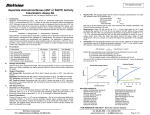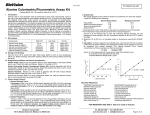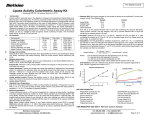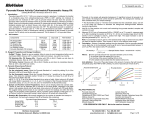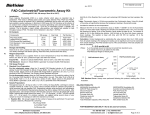Download BioVision
Transcript
II. Introduction: Alanine aminotransferase (ALT) is a transaminase (EC 2.6.1.2) also called serum glutamic pyruvic transaminase (SGPT) or alanine transaminase. ALT is found in serum and in various body tissues, but is usually associated with the liver. It catalyzes the reaction: α-ketoglutarate + alanine ⇌ glutamate + pyruvate It is commonly measured clinically as a part of a diagnostic liver function test to determine liver health. Diagnostically, it is almost always measured in units/liter (U/L). In BioVision’s ALT Assay Kit, ALT catalyzes the transfer of an amino group from alanine to ⍺-ketoglutarate, the products of this reversible transamination reaction being pyruvate and glutamate. The pyruvate is detected in a reaction that concomitantly converts a nearly colorless probe to both color (λmax = 570 nm) and fluorescence (Ex/Em = 535/587 nm). The kit provides a rapid, simple, sensitive, and reliable test suitable for high throughput activity assay of ALT with a detection limit of 10 mU per well. Kit Contents: Components ALT Assay Buffer OxiRed™ (in DMSO) ALT Enzyme Mix (lyophilized) ALT Substrate (lyophilized) Pyruvate Standard (100 nmol/µl) ALT Positive Control (lyophilized) 100 assays 25 ml 200 µl 1 vial 1 vial 100 µl 1 vial Cap Code WM Red Green Orange Yellow Blue Part Number K752-100-1 K752-100-2A K752-100-3 K752-100-4 K752-100-5 K752-100-6 III. Storage and Handling: Store the kit at -20°C, protect from light. Allow ALT Assay Buffer to warm to room temperature before use. Briefly centrifuge vials before opening. Read the entire protocol before performing the assay. IV. Reagent preparation: ALT Enzyme Mix: Reconstitute with 220 µl dH2O. Aliquot and store at -20oC. Use within two months. ALT Substrate: Reconstitute with 1.1 ml Assay Buffer. Aliquot and store at -20oC. Use within two months. ALT Positive Control: Reconstitute with 100 µl dH2O. Aliquot and store at -20oC, use within two months. In the assay (optional), add 5-10 µl positive control and adjust the final volume to 20 µl/well with ALT Assay Buffer. V. ALT Assay Protocol: 1. Standard Curve Preparation: Colorimetric assay: Dilute the Pyruvate Standard to 1 nmol/µl by adding 10 µl of the Standard to 990 µl of ALT Assay Buffer, mix well. Add 0, 2, 4, 6, 8, 10 µl into a series of standards wells. Adjust volume to 20 µl/well with ALT Assay Buffer to generate 0, 2, 4, 6, 8, 10 nmol/well of the Pyruvate Standard for the colorimetric assay. Fluorometric assay: Dilute the Pyruvate Standard to 1 nmol/µl as for the colorimetric assay. Then dilute the standard another 10-fold to 0.1 nmol/µl by taking 10 µl into 90 µl of ALT Assay Buffer. Mix well. Add 0, 2, 4, 6, 8, 10 µl into a series of standards wells. Adjust volume to 20 µl/well with ALT Assay Buffer to generate 0, 0.2, 0.4, 0.6, 0.8, 1.0 nmol/well of the Pyruvate Standard for the fluorometric assay. 2. Sample Preparations: Tissues (50 mg) or cells (1 x 106) can be homogenized in 200 µl icecold ALT Assay Buffer, then centrifuged (13,000 x g, 10 min) to remove insoluble material. BioVision Incorporated 155 S. Milpitas Boulevard, Milpitas, CA 95035 USA 5. 6. ALT Activity = B (T2−T1)× V = nmol/min/ml = mU/ml Where: B is the pyruvate amount from pyruvate Standard Curve (in nmol). T1 is the time of the first reading (A1) (in min). T2 is the time of the second reading (A2) (in min). V is the original sample volume added into the reaction well (in ml). One unit of ALT is defined as the amount of ALT which generates 1.0 µmol of pyruvate per minute at 37 °C. a) 1.5 b) 1 0.5 y = 0.1048x - 0.0382 0 0 c) 1 5 10 Pyruvate (nmoles) Positive control initial lag phase 0.5 Positive Ctrl. Background 0 0 10000 8000 6000 4000 2000 0 RFU (Catalog #K752-100; 100 assays; Store kit at -20°C) I. 20 40 Time (min) 60 y = 9078.4x + 181.74 0 d) 25 Specific Activity (mU/mg) 4. RFU Alanine Aminotransferase (ALT or SGPT) Activity Colorimetric/Fluorometric Assay Kit OD 570 nm 3. For research use only rev. 1/15 Serum samples can be directly diluted in the Assay Buffer. Prepare test samples of up to 20 µl/well with Assay Buffer in a 96-well plate. We suggest testing several doses of your sample to make sure the readings are within the standard curve range. Reaction Mix: Mix enough reagents for the number of assays to be performed. For each well, prepare a total 100 µl Reaction Mix: ALT Assay Buffer 86 µl OxiRed Probe 2 µl ALT Enzyme Mix 2 µl ALT Substrate 10 µl Add 100 µl of the Sample Reaction Mix to each well containing the Samples, Standards, and Positive Controls (optional). Mix well. *Note: The fluorometric assay is ~10 times more sensitive than the colorimetric assay. Use 0.4 µl of the probe per reaction to decrease the background reading & increase detection sensitivity significantly. Measurement: Read OD 570 nm (A1) at T1 (T1 > 10min) then again (A2) at T2 after incubating the reaction at 37 °C for 60 min (or longer if the ALT activity is low), protect from light. The OD of the color generated by oxidation of pyruvate is ∆A570 nm = A2 – A1. It is recommended that the user run the assay kinetically to choose A1 and A2 values which occur after the initial lag phase, during the linear range of color development. OD at A 2 should not exceed the highest OD in the standard curve. Calculation: Plot the pyruvate Standard Curve and use the ∆A570 nm to obtain B nmol of pyruvate (amount of pyruvate generated between T1 and T2 in the reaction wells). ALT activity in the test samples can then be calculated: OD 570 nm BioVision 20 0.25 0.5 0.75 Pyruvate (nmol) 1 15 10 5 0 HepG2 Lysate Liver Lysate Figure: Pyruvate Standard Curve a) Colorimetric, b) Fluorometric. Measurement of alanine aminotransferase activity in Positive Control (c) and HepG2 Cells (10 ug) and Liver Lysate (15 ug) (d). Assays were performed following the kit protocol. FOR RESEARCH USE ONLY! Not to be used on humans. Tel: 408-493-1800 | Fax: 408-493-1801 www.biovision.com | [email protected] Page 1 of 2 BioVision rev. 1/15 For research use only GENERAL TROUBLESHOOTING GUIDE: Problems Cause Solution Assay not working • Use of ice-cold assay buffer • Assay buffer must be at room temperature • Omission of a step in the protocol • Refer and follow the data sheet precisely • Plate read at incorrect wavelength • Check the wavelength in the data sheet and the filter settings of the instrument • Fluorescence: Black plates (clear bottoms) ; Luminescence: White plates ; Colorimeters: Clear plates • Use of a different 96-well plate Samples with erratic readings • Use of an incompatible sample type • Refer data sheet for details about incompatible samples • Samples prepared in a different buffer • Use the assay buffer provided in the kit or refer data sheet for instructions • Samples used after multiple free-thaw cycles • Use Dounce homogenizer (increase the number of strokes); observe for lysis under microscope • Aliquot and freeze samples if needed to use multiple times • Presence of interfering substance in the sample • Troubleshoot if needed • Use of old or inappropriately stored samples • Use fresh samples or store at correct temperatures until use • Improperly thawed components • Thaw all components completely and mix gently before use • Use of expired kit or improperly stored reagents • Always check the expiry date and store the components appropriately • Allowing the reagents to sit for extended times on ice • Always thaw and prepare fresh reaction mix before use • Incorrect incubation times or temperatures • Refer datasheet & verify correct incubation times and temperatures • Incorrect volumes used • Use calibrated pipettes and aliquot correctly • Use of partially thawed components • Thaw and resuspend all components before preparing the reaction mix • Pipetting errors in the standard • Avoid pipetting small volumes • Pipetting errors in the reaction mix • Prepare a master reaction mix whenever possible • Air bubbles formed in well • Pipette gently against the wall of the tubes • Standard stock is at an incorrect concentration • Always refer the dilutions in the data sheet • Calculation errors • Recheck calculations after referring the data sheet • Substituting reagents from older kits/ lots • Use fresh components from the same kit • Measured at incorrect wavelength • Check the equipment and the filter setting • Samples contain interfering substances • Troubleshoot if it interferes with the kit • Use of incompatible sample type • Refer data sheet to check if sample is compatible with the kit or optimization is needed • Sample readings above/below the linear range • Concentrate/ Dilute sample so as to be in the linear range • Cell/ tissue samples were not completely homogenized Lower/ Higher readings in Samples and Standards Readings do not follow a linear pattern for Standard curve Unanticipated results Note: The most probable list of causes is under each problem section. Causes/ Solutions may overlap with other problems. BioVision Incorporated 155 S. Milpitas Boulevard, Milpitas, CA 95035 USA Tel: 408-493-1800 | Fax: 408-493-1801 www.biovision.com | [email protected] Page 2 of 2


